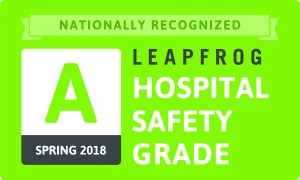NEA Baptist Receives an ‘A’ for Patient Safety
awards news quality care safety / May 23, 2018
NEA Baptist Receives an ‘A’ for Patient Safety
The Leapfrog Group recently released the new Leapfrog Hospital Safety Grades. NEA Baptist was one of 750 in the nation awarded an ‘A’ for its efforts in protecting patients from harm and meeting the highest safety standards in the U.S. The Safety Grade assigns an A, B, C, D or F grade to hospitals across the country based on their performance in preventing medical errors, infections and other harms among patients in their care.
“We are extremely proud of our team and their dedication to providing high quality care at NEA Baptist,” said chief nursing officer, Paula Grimes, MSN, RN. “Our focus is always on the continuous improvement of the care and safety of our patients. We appreciate the transparency of reports like this from Leapfrog which utilize nationally reported data that measures quality and safety outcomes and processes. The “A” grading is something we are proud of; however, we are most proud to see that this report, along with others such as Healthgrades, supports our commitment to providing a high quality care and an exceptional experience for our patients and their families. Thank you to our nurses, providers and everyone on the team at NEA Baptist for helping us achieve this.”
Who is Leapfrog?
The Leapfrog Group is a national nonprofit organization, based out of Washington D.C, driving a movement for giant leaps forward in the quality and safety of American health care.
The flagship Leapfrog Hospital Survey collects and transparently reports hospital performance, empowering purchasers to find the highest-value care and giving consumers the lifesaving information they need to make informed decisions. The Leapfrog Hospital Safety Grade, Leapfrog’s other main initiative; assigns letter grades to hospitals based on their record of patient safety, helping consumers protect themselves and their families from errors, injuries, accidents, and infections.
What is the Hospital Safety grade?
Developed under the guidance of an Expert Panel, the Leapfrog Hospital Safety Grade uses 27 measures of publicly available hospital safety data to assign grades to approximately 2,500 U.S. hospitals twice per year. It is peer reviewed, fully transparent and free to the public.
“This is the only national rating of how well hospitals protect patients from preventable harm and death, such as medical errors, infections, and injuries,” said Leah Binder, President and CEO of The Leapfrog Group. “Receiving an ‘A’ Safety Grade means a hospital is among the best in the country for preventing these terrible problems and putting their patients first, 24 hours a day.”
What does it measure?
The Leapfrog Hospital Safety Grade looks at publicly available measures of safety – inpatient injuries, infections, and medical and medication errors.
Outcome Measures include, among other measures:
- Infections, including: central line-associated bloodstream infections, catheter-associated urinary tract infections, surgical site infections for colon surgery, MRSA and C. diff.
- Falls and trauma, very severe pressure ulcers
- Preventable complications from surgery such as foreign objects retained in the body and accidental punctures or lacerations
Process/Structural Measures include, among other measures:
- Strong nursing leadership and engagement
- Computerized physician order entry systems to prevent medication errors
- hand hygiene policies and the right staffing for the ICU
Where does the data come from?
The Leapfrog Hospital Safety Grade primarily consists of measures collected and publicly reported by the Centers for Medicare & Medicaid Services (CMS), and also includes some measures from the Leapfrog Hospital Survey for hospitals that report to Leapfrog. If a hospital does not submit a Leapfrog Hospital Survey, Leapfrog uses data from the American Hospital Association’s annual survey and IT supplement instead. Hospitals are not penalized for not reporting to Leapfrog.
How is the data assessed?
The scoring algorithm was developed by an Expert Panel of patient safety experts from across the country. The panel carefully considers the evidence base and opportunity for impact behind each of the 27 measures, and weight the importance of each of the measures based in part on the strength of that evidence. The Panel regularly reconvenes to reevaluate the merits of each measure. Leapfrog’s transparent methodology involves computing data for these 27 measures through a scoring algorithm and then assigning each hospital an A, B, C, D, or F letter grade.
You can find more information and the full methodology at www.HospitalSafetyGrade.org.

Back to blog
